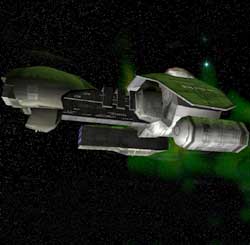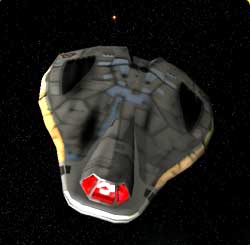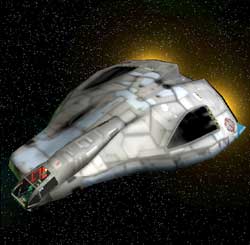CARRIERS
 |
Manufacturer: Von Schelling Industries
Length: 1.5km
Mass: CLASSIFIED
Crew: CLASSIFIED
Maneuverability: Very Low
Offensive Systems:
CLASSIFIED
Defensive Systems:
CLASSIFIED
Drive Systems:
CLASSIFIED
The Capital class carrier is one of the largest ships in space. Though ships are often retrofitted to carry fighters and other vessels, the Capital Carrier is a specialised launching platform capable of deploying a wide variety of fighters, interceptors and even patcom and corvette class vessels. Typically the Capital class is used a flagship by large Government and Corporate navies, and is never deployed without appropriate escorts, as its size makes it an obvious (though very tough) target. The exact defensive capabilities of the Capital class are unknown, being classified, but it is believed to be armed with numerous wide-aspect turrets, and military sources suggest it has at least one anti-capital ship beam weapon. Capital class carriers replaced the old Alabama class carriers after the Alabama class was deemed to be too vulnerable due to heavy combat losses. The prototype Capital carrier was designed using a Danube class cruiser frame fitted with an Alabama's launch frame, though the final version is larger by 50% than the two ships combined.
COMMAND SECTIONS
NSO-1502 Advanced Command Section
 |
 |
Manufacturer: NSO Laplace
Length: 28m
Mass: 110t
Crew: 3 - 4
Maneuverability: High
Offensive Systems:
Light PBC Cannon
Defensive Systems:
LDA (Upper)
Drive Systems:
Standard Thruster Array
LDS Class 1
The NSO-1502 Command section is a direct descendant of the classic NSO-401 command section. Though designed as the primary control section of a patcom or corvette class vessel, it is in fact an autonomous space vessel in its own right. A major improvement over earlier models is the inclusion of a Class 1 LDS drive which enables the ship to travel interplanetary distances - albeit somewhat slowly. The military version also sports a hardpoint for a Light PBC Cannon or comms laser, following earlier concerns of vulnerability to attack if separated from its mother vessel. Typically it carries a command crew of three to four - a Commander, Pilot, Gunner ( on military vessels ) and an Engineer. It is believed that at one point NSO Laplace experimented with a one to two-man version, but the project was abandoned before it reached production, due to the highly complex nature of the avionics required. No prototype is known to exist.













